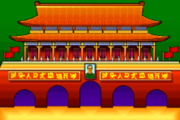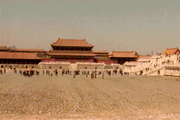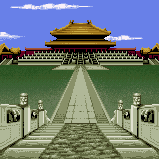Forbidden City: Difference between revisions
From the Super Mario Wiki, the Mario encyclopedia
Jump to navigationJump to search
No edit summary |
Derekblue1 (talk | contribs) (Added names in other languages) |
||
| (6 intermediate revisions by 3 users not shown) | |||
| Line 1: | Line 1: | ||
{{multiple image | |||
|align=right | |||
{{ | |direction=vertical | ||
The '''{{wp|Forbidden City}}''', now called the '''Palace Museum''' (Chinese: '''紫禁城'''; Pinyin: ''Zǐjìnchéng''; Manchu: '''ᡩᠠᠪᡴᡡᡵᡳᡩᠣᡵᡤᡳᡥᠣᡨᠣᠨ''', ''Dabkūri Dorgi Hoton''), is a building located in central [[Beijing]] that used to serve as a palace for the Chinese Emperors of the {{wp|Ming dynasty|Ming}} and {{wp|Qing dynasty|Qing}} dynasties. In | |width=180 | ||
|footer=Forbidden City in DOS, ''CD-ROM Deluxe'' and SNES versions. | |||
|image1=Forbidden City MIMDOS.png | |||
|alt1=DOS | |||
|image2=Forbidden City MIMCD.png | |||
|alt2=''CD-ROM Deluxe'' | |||
|image3=ForbiddenCity MIM.png | |||
|alt3=SNES | |||
}} | |||
{{quote|The Gateway of Heavenly Peace, Tian An Men, was built in AD 1651. An impressive 110 feet tall, Heavenly Peace is the main entrance to Forbidden City, which has been renamed the Palace Museum. Once the walled estate of emperors, only the Emperor himself was permitted to use Tian An Men -- guards kept everyone else out. Those entitled to visit the City had to use a separate entry. In 1949, the leader, Mao Zedong stood at the Gate to announce the formation of the People's Republic of China, the present day Communist government.|'''Pamphlet'''|Mario is Missing! (PC)}} | |||
The '''{{wp|Forbidden City}}''', now called the '''Palace Museum''' (Chinese: '''紫禁城'''; Pinyin: ''Zǐjìnchéng''; Manchu: '''ᡩᠠᠪᡴᡡᡵᡳᡩᠣᡵᡤᡳᡥᠣᡨᠣᠨ''', ''Dabkūri Dorgi Hoton''), is a building located in central [[Beijing]] that used to serve as a palace for the Chinese Emperors of the {{wp|Ming dynasty|Ming}} and {{wp|Qing dynasty|Qing}} dynasties. In the [[Mario is Missing! (PC)|PC]], [[Mario is Missing! (Super Nintendo Entertainment System)|SNES]], and [[Mario is Missing! (Nintendo Entertainment System)|NES versions of ''Mario is Missing!'']], it is one of the landmarks that gets raided by [[Koopa Troopa]]s. They steal the entire [[Gate of Heavenly Peace]], causing the whole place to be shut down to the public until it is returned. After Luigi takes back the Gate, brings it to the Forbidden City's information booth, and proves that the item in his possession is genuine through some questions (seen below), the Forbidden City becomes open once more. | |||
{{br|left}} | {{br|left}} | ||
*''Who was forbidden from entering Forbidden City through the Heavenly Gateway?'' | *''Who was forbidden from entering Forbidden City through the Heavenly Gateway?'' | ||
**Everyone and everything | **Everyone and everything | ||
**The Emperor's new clothes | **The Emperor's new clothes/The Emperor's tailor (NES) | ||
**'''Everyone but the Emperor''' | **'''Everyone but the Emperor''' | ||
**The Emperor's daughter | **The Emperor's daughter | ||
*''What is Forbidden City's present name?'' | *''What is Forbidden City's present name?'' | ||
**Taboo Town | **Taboo Town | ||
**'''The Palace Museum''' | **'''The Palace Museum'''/'''Palace Museum''' (NES) | ||
**Heavenly Peace | **Heavenly Peace | ||
**Tian An Men | **Tian An Men | ||
*''Who built the heavenly gate?'' | *''Who built the heavenly gate?'' | ||
**'''Yung Le''' | **'''Yung Le'''/'''Yung Lee''' (NES) | ||
**Mao Zedong | **Mao Zedong | ||
**Mao Tse Tung | **Mao Tse Tung | ||
| Line 26: | Line 36: | ||
|description1=Live-action footage of the Forbidden City in the Deluxe version of ''Mario is Missing!'' | |description1=Live-action footage of the Forbidden City in the Deluxe version of ''Mario is Missing!'' | ||
|length1=0:20 | |length1=0:20 | ||
}} | |||
==Names in other languages== | |||
{{foreign names | |||
|Ger=Die Verbotene Stadt | |||
|GerM=The Forbidden City | |||
|GerC=<ref>{{cite|publisher=[[Software Toolworks]]|title=''Mario wir vermisst''|language=German|accessdate=September 23, 2024}}</ref> | |||
}} | }} | ||
| Line 31: | Line 48: | ||
*One of the question's answers references {{wp|Kwai Chang Caine}}, the protagonist of the ABC television series, ''{{wp|Kung Fu (TV series)|Kung Fu}}''. | *One of the question's answers references {{wp|Kwai Chang Caine}}, the protagonist of the ABC television series, ''{{wp|Kung Fu (TV series)|Kung Fu}}''. | ||
==References== | |||
<references/> | |||
{{Earth}} | {{Earth}} | ||
{{MIM}} | {{MIM}} | ||
[[Category:Buildings]] | [[Category:Buildings]] | ||
[[Category:Mario is Missing! landmarks]] | [[Category:Mario is Missing! landmarks]] | ||
Latest revision as of 10:21, September 23, 2024
- “The Gateway of Heavenly Peace, Tian An Men, was built in AD 1651. An impressive 110 feet tall, Heavenly Peace is the main entrance to Forbidden City, which has been renamed the Palace Museum. Once the walled estate of emperors, only the Emperor himself was permitted to use Tian An Men -- guards kept everyone else out. Those entitled to visit the City had to use a separate entry. In 1949, the leader, Mao Zedong stood at the Gate to announce the formation of the People's Republic of China, the present day Communist government.”
- —Pamphlet, Mario is Missing! (PC)
The Forbidden City, now called the Palace Museum (Chinese: 紫禁城; Pinyin: Zǐjìnchéng; Manchu: ᡩᠠᠪᡴᡡᡵᡳᡩᠣᡵᡤᡳᡥᠣᡨᠣᠨ, Dabkūri Dorgi Hoton), is a building located in central Beijing that used to serve as a palace for the Chinese Emperors of the Ming and Qing dynasties. In the PC, SNES, and NES versions of Mario is Missing!, it is one of the landmarks that gets raided by Koopa Troopas. They steal the entire Gate of Heavenly Peace, causing the whole place to be shut down to the public until it is returned. After Luigi takes back the Gate, brings it to the Forbidden City's information booth, and proves that the item in his possession is genuine through some questions (seen below), the Forbidden City becomes open once more.
- Who was forbidden from entering Forbidden City through the Heavenly Gateway?
- Everyone and everything
- The Emperor's new clothes/The Emperor's tailor (NES)
- Everyone but the Emperor
- The Emperor's daughter
- What is Forbidden City's present name?
- Taboo Town
- The Palace Museum/Palace Museum (NES)
- Heavenly Peace
- Tian An Men
- Who built the heavenly gate?
- Yung Le/Yung Lee (NES)
- Mao Zedong
- Mao Tse Tung
- Kwai Chang Cain
Media[edit]
| File info 0:20 |
Names in other languages[edit]
| Language | Name | Meaning | Notes |
|---|---|---|---|
| German | Die Verbotene Stadt[1] | The Forbidden City |
Trivia[edit]
- One of the question's answers references Kwai Chang Caine, the protagonist of the ABC television series, Kung Fu.
References[edit]
- ^ Mario wir vermisst. Software Toolworks (German). Retrieved September 23, 2024.


